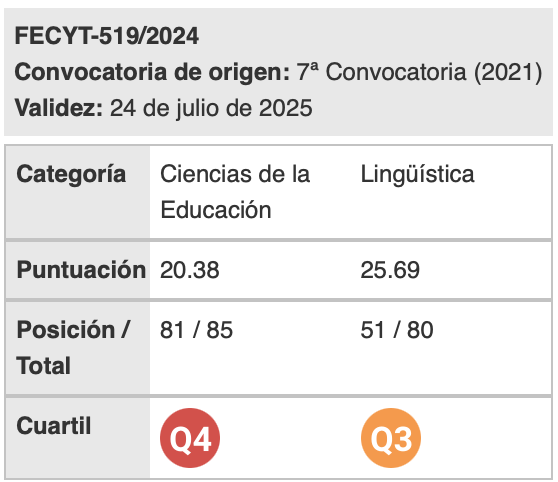Identifying moves and elements of persuasion in collection letters
Keywords:
Move analysis, persuasion, genre analysis, English for specific purposes.Abstract
Collection letters are meant to collect balances due and at the same time they attempt to encourage a business relationship and its revenue flow to continue. This type of correspondence is nowadays one of the few types of correspondence that is not maintained electronically because in the different stages of the collection process, these letters can acquire certain legal power. In these extremely difficult days for the financial world, collection letters have become a frequent means of correspondence between collectors and debtors in several countries, which makes it necessary to carefully analyze this particular genre in order to raise awareness of its structural organization and content, particularly to help language users who may not be familiar with this genre in their own cultures. This study looks at the collection letter as business correspondence that consists of specific moves that function together to persuade debtors to pay the agreed-upon amount that is legitimately owed to the creditor. The study also explores the different stages of the collection process and the functional and rhetorical approaches that are found at each of these stages, analyzing the frequency of the moves identified in the letters and the different uses of those moves. The results of this study show that requesting the debtor to communicate with the creditor is undoubtedly the most frequently used strategy for achieving the two major purposes of this type of correspondence.
Downloads
References
Aubuchon, N. (1997). The anatomy of persuasion. New York, AMACOM.
Bazerman, C. (1994). Systems of genres and the enactment of social interactions. In A. Freedman and P. Medway (Eds.), Genre and the new rhetoric (pp. 79-101). London: Taylor and Francis.
Bhatia, V. (1993). Analyzing genre: Language in professional settings. London: Longman.
Bosworth, B. (2004). Under the influence. Credit Management, June, 32-34 Retrieved June 8, 2006, from http://www.allbusiness.com/ business-finance/business- loans-business-credit/1128658-1.html.
Connor, U., & Gladkov, K. (2004). Rhetorical appeals in fundraising direct mail letters. In U. Connor and T. Upton (Eds.), Discourse in the professions (pp. 257- 286). Philadelphia: John Benjamins.
Dominy, N. & Kempson, E. (2003). Can’t pay or won’t pay? A review of creditor and debtor approaches to the non-payment of bills [Electronic version.] Personal Finance Research Centre 4 (3), University of Bristol.
Flowerdew, J. & Wan, A. (2006). Genre analysis of tax computation letters; How and why tax accountants write the way they do. English for Specific Purposes 25, 133-153.
Hanel, S. (2006). Moves in collection letters. Unpublished Manuscript. Iowa State University. Ames, Iowa.
Hanel, S. (2007). Moves in collection letters. Unpublished Manuscript. Iowa State University. Ames, Iowa.
Johns, A., Bawarshi, A., Coe, R., Hyland, K., Paltridge, B., Reiff, M. J. & Tardy, C. (2006). Crossing the boundaries of genre studies: Commentaries by experts. Journal of Second Language Writing 15, 234-249.
Lawrence, N. (1974). Writing communications in business and industry. Englewood Cliffs, NJ: Prentice-Hall.
Luecke. R. (2005). Power, influence and persuasion: Sell your ideas and make things happen. Boston, MA: Harvard Business School Publishing.
Rock, P. E. (1968). Observation on debt collection. The British Journal of Sociology 19(2), 176-190.
Sant, T. (2004). Persuasive business proposals. New York, NY. AMACOM. Spinks, N., & Wells, B. (1997). Collection communication: a problem child of
management. Management Decision 35(2), 106-109.
Swales, J. (1981). Aspects of research article introductions. Aston ESP Research
Report N 1. Birmingham: The University of Aston.
Swales, J. (1990). Genre analysis. Cambridge: Cambridge University Press. Swales, J. (2004). Research genres. Cambridge: Cambridge University Press.
Van Nus, M. (1999). Can we count on the bookings of potatoes to Madeira? Corporate context and discourse practices in direct sales letters. In F. Bargiela- Chiappini and C. Nickerson (Eds.), Writing business: Genres, media and discourses. (pp 181-205). London: Longman.
Downloads
Published
How to Cite
Issue
Section
License
Authors who publish with this journal agree to the following terms:
- Authors retain copyright and grant the journal right of first publication with the work simultaneously licensed under a Creative Commons Attribution License that allows others to share the work with an acknowledgement of the work's authorship and initial publication in this journal.
- Authors are able to enter into separate, additional contractual arrangements for the non-exclusive distribution of the journal's published version of the work (e.g., post it to an institutional repository or publish it in a book), with an acknowledgement of its initial publication in this journal.
- Authors are permitted and encouraged to post their work online (e.g., in institutional repositories or on their website) prior to and during the submission process, as it can lead to productive exchanges, as well as earlier and greater citation of published work (See The Effect of Open Access).

Revista de Lenguas para fines específicos is licensed under a Creative Commons Reconocimiento-NoComercial-SinObraDerivada 4.0 Internacional License.
























